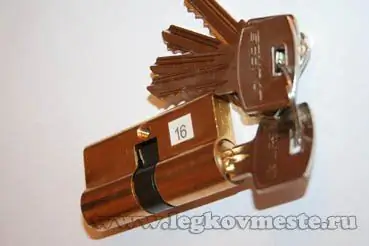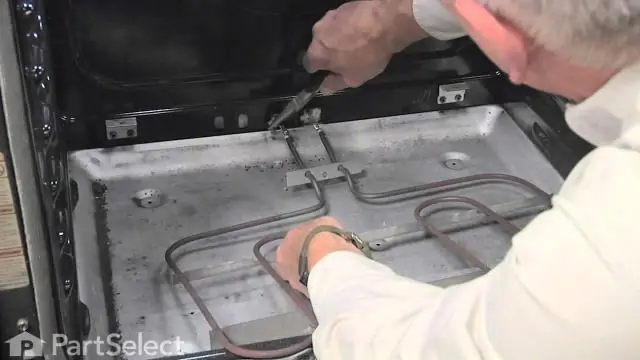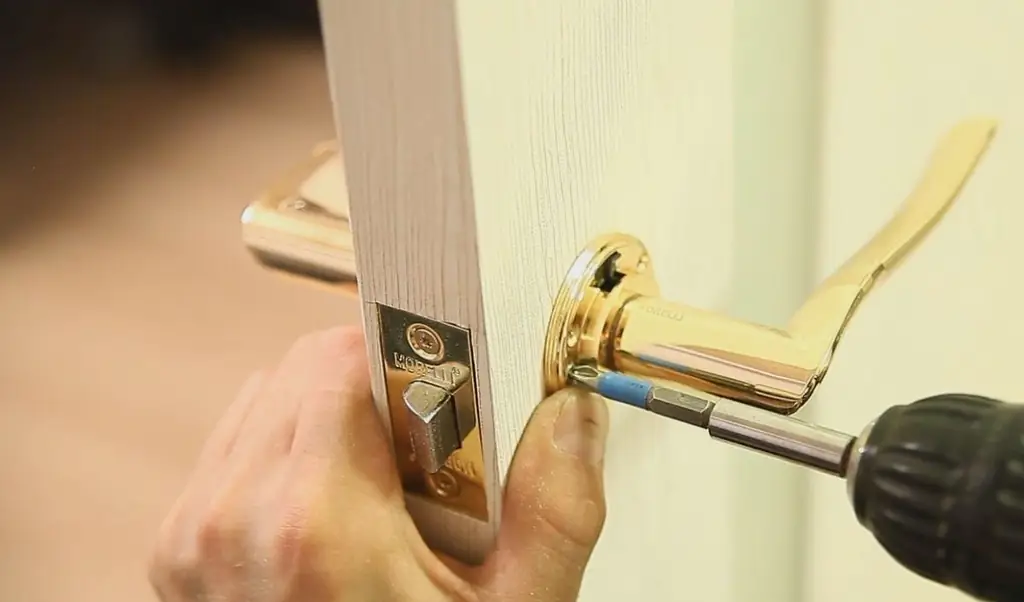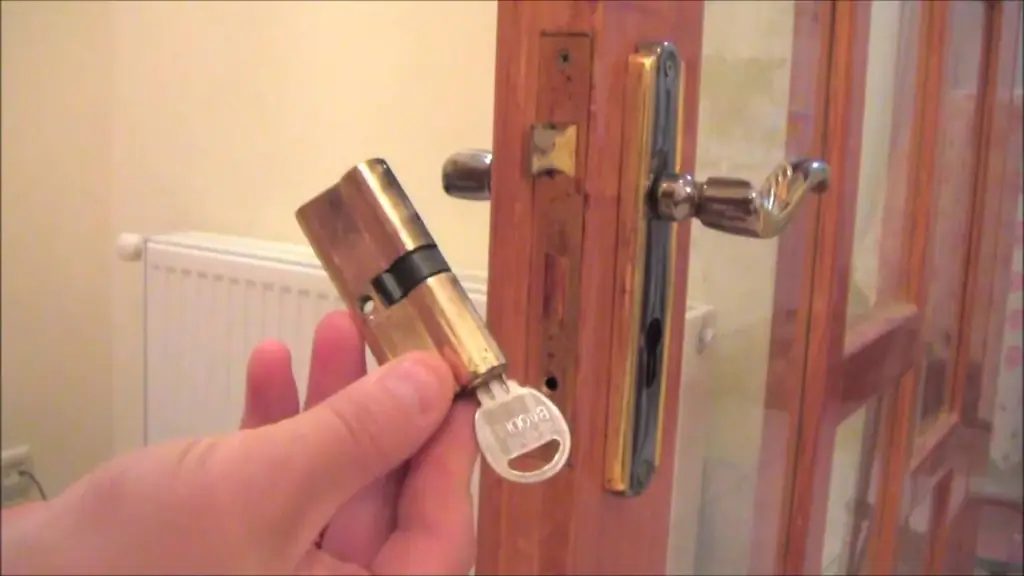
Table of contents:
- Author Bailey Albertson [email protected].
- Public 2023-12-17 12:53.
- Last modified 2025-01-23 12:41.
Replacing the lock cylinder in the door

Each of us uses locks every day. Starting from the fact that we leave home and close the door behind us, and ending with locking the car doors, and just lock bags and briefcases with code mechanisms. Our life is completely intertwined with doors and secret locks. And, of course, sooner or later we are faced with a situation when the castle fails. This is a natural process, because everything in this world gets old and begins to break down. And if this happens, repair or complete replacement of the mechanism is required.
Of course, there are completely different cases, but which are also associated with the locks of the front doors. So, for example, very often the question arises of replacing keys with an already existing secret mechanism. This may be due to the loss of keys by one of the family members, the need to restrict access to the premises for people who already have keys, and simply with the reason for the poor performance of its functions by the lock cylinder (jamming, poor rotation, etc.).
It is in this case that the need arises to replace the lock larva, which we will now consider.
What is a castle larva?
This is exactly the part with the secret mechanism, into which the key is inserted, and which checks the correspondence of our key to the given mechanism.
The very procedure of replacing the lock cylinder is much easier than replacing the entire lock in the door, because this is practically the first operation with a complete replacement of the locking mechanism. And in total, it won't take more than 10 minutes.
Replacing the lock cylinder in the door
We arm ourselves with a Phillips screwdriver and begin the repair procedure. First of all, we open the door and from the end we find a bolt in the end plate, which secures the larva (it is located approximately in the middle of the plate). Insert a screwdriver into it and rotate it counterclockwise, unscrew it, as shown in the photo below.

Remove the bolt completely from the hole. The larva, which we are changing, began to move, but does not get out of its nest. To understand why this is happening, take a look at the photo below.

The photo on the left shows the secret mechanism with the flag extended, as it is located in the locking mechanism in its normal state with the keys removed. The right photo shows the flag already recessed. So this extended flag prevents our larva from leaving the nest when the fastening bolt is unscrewed.
You can remove the flag inside only by inserting the key and turning it in the larva 10-15 degrees clockwise. Thus, we insert the key, turn it by 10-15 degrees and, pulling it away from the door (as shown in the photo below), or pushing the secret mechanism from the back of the door, remove it from its socket.

That's it, at this the first stage of the operation to replace the castle larva is completed. The larva is in your hands, i.e. now you have a sample that you need to buy.
Tips for choosing and installing a new maggot
We go to the store and buy a new larva.
When choosing, you need to pay attention:
- To select the desired size of the larva, both in length and in diameter. They come in different lengths (since the thickness of the doors is different for everyone). The diameter may also differ if it is an imported manufacturer.
- According to the configuration of the larva, it is necessary to look at the location of the mounting hole (the one from where we unscrewed the mounting bolt). The distance from the end of the larva to the hole on the new larva should not be less than the same distance on the old key larva, both on one side and on the other. (It can only be equal or greater. More is acceptable, but then your secret mechanism will look out of the lock a little more than the old model).
- The larvae are equipped with a different number of keys (choose how many you need, whatever happens after the purchase, that someone from the family members will not get the key).
- They come with keyways on both sides (as in our example), but there are: on the one side the keyway is the street side of the lock, and on the other side there can be a "spinner" - to open the lock from the inside without a key.
- They also differ in the shape of the keys (since there are a huge variety of types of keys: from simple flat "English" keys to complex perforated or laser keys.

And the last one:
6. Pay attention to the color of the chosen larva, it should be in harmony with the color of your castle.
If a situation arises that it is not possible to take the mechanism with you (for example, because it is in the front door and it is undesirable to leave the house open), then we simply remove the dimensions from our larva (mainly the length, diameter, distance from the end to the mounting hole and the manufacturer's firm (in our case "Bulat")). We visually remember its color and insert it back, before purchasing a new part.
After we have decided and bought a new larva, it remains only to put it back in place.
Installation operations are carried out in the reverse order of removal. The biggest difficulty can only arise when the mounting bolt hits the hole. To cope with this problem will help a slight movement of the larva across the plane of the lock with the simultaneous baiting of the fastening bolt.
Functional check
After replacing the lock cylinder, be sure to try the operation of the lock on an open door, both from the inside and from the outside of the door. If everything is done correctly, the key should turn freely in the lock. The lock must open and close freely, the bolt must freely leave the lock and come back. The lock should not make any squeaking or creaking sounds.
If everything works well, you can try to open and close the locking mechanism in the closed position of the door.
In this way, replacing the door lock cylinder with your own hands is simple and easy.
Good luck to everyone and less troublesome repairs.
Yours faithfully, Ponomarev Vladislav.
Recommended:
Replacing The Fan Of The Kalina Stove: How To Change If It Does Not Work, Do It Yourself Repair

The main functions of the heating fan and its location. Reasons for replacing the fan and signs of failure. Fan and resistor replacement process
How To Quickly Peel Squids, Including Frozen Ones, And Quickly Get Rid Of The Film + Photos And Videos

Do you think peeling squid is a difficult and energy consuming task? We will dissuade you of this
Step-by-step Instructions For Replacing The Lock On The Door: Tools And Work Steps, Expert Advice And Recommendations

Types and types of door locks. How to determine the type of lock yourself. How to replace the lock in case of breakage. Required tools and materials. Work order
Step-by-step Instructions For Replacing The Lock Cylinder: Tools And Stages Of Work, Advice And Recommendations From Specialists

Varieties of larvae depending on the type of castle. In what cases the larva is changed. Stages of work, required tools. Specialist tips for lock maintenance
When Kittens Change Their Teeth, At What Age Does Milk Change To Permanent Ones, How To Care For A Pet During This Period

How does a cat's teeth form and change; what is normal and what is not; when to see a doctor, how to take care of a kitten, veterinarian advice
